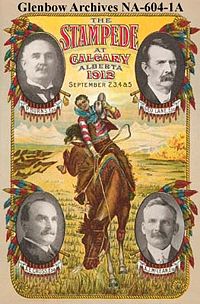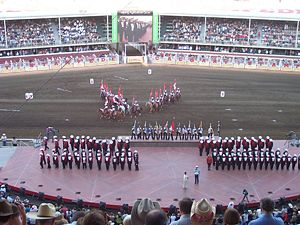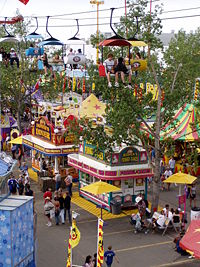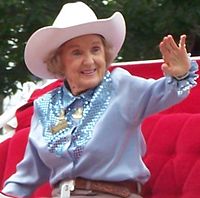Calgary Stampede




The Calgary Stampede, which bills itself as The Greatest Outdoor Show on Earth, is a large festival, exhibition, and rodeo held in Calgary, Alberta for 10 days every summer from early to mid-July. It is one of Canada's largest annual events, and the world's largest outdoor rodeo. It features an internationally recognized rodeo competition, a midway, stage shows, concerts, agricultural competitions, chuckwagon races, First Nations exhibitions, and pancake breakfasts around the city, among other attractions. In 2006, record-breaking attendance at the 10-day rodeo and exhibition totalled 1,262,518. The Calgary Stampede Rodeo Committee was inducted into the ProRodeo Hall of Fame in 2008. The Stampede Parade which occurs on opening day, is one of the festival's oldest and largest traditions. It is led by the Calgary Stampede Showband and follows a 4.5 km route in downtown Calgary. Attendance at the parade is usually about 350,000. The parade is also televised and has a viewing audience of over 2 million. During Stampede Week, the city is flooded with tourists who join locals in the spirited atmosphere by dressing in western attire. A large number of businesses decorate their stores and offices in western style, usually starting in June and remaining to after the Stampede ends.
The Calgary Stampede takes place at the Stampede Grounds, located southeast of downtown Calgary in the Beltline District. The park is serviced by Calgary Transit's light rail system, the C-Train as well as local property owners who rent parking spaces during the 10 days of the exhibition. Permanent structures at the site include the Pengrowth Saddledome (hockey arena), the Round-Up Centre (a convention and exhibition facility), the Stampede Casino, the grandstand/racetrack, the agriculture building, and a number of smaller buildings. A major expansion and upgrading of the grounds is currently underway. It will likely include a new hotel, a new casino, a new "main street" retail and market area, a new agriculture building, underground parking, and an extensive re-landscaping of the outdoor areas.
The event has generated controversy due to a number of animal deaths, particularly those linked to the traditional chuckwagon races. Despite these animal deaths, the chuckwagon races, rodeo and Calgary Stampede have a very high level of community support, and it is unlikely that these deaths will result in the termination of the chuckwagon races or the rodeo, both of which are defining aspects of this Calgary cultural icon.
Contents |
History
General Overview
The Calgary Exhibition was first held in 1886 soon after the arrival of the Canadian Pacific Railway in the city. The Calgary Stampede (a separate event) was inaugurated in 1912 by Guy Weadick, an American trick roper, and financed by the Big Four: Pat Burns, George Lane, A.J. MacLean, and A.E. Cross. Weadick wanted to put on a world-class rodeo event and Wild West show that would bring the best cowboys from across the continent. The first Stampede, which drew over 100,000 spectators was the richest rodeo competition in North America with prize money totalling $20,000, and it remains one of the premier rodeo events to this day with over $1,000,000.00 in prize money being handed out to winners on the final Sunday of competition. In 1923, the Stampede was combined with the Calgary Exhibition and the event has taken place every year since.
The Midway is run by North American Midway Entertainment, who also operate the Canadian National Exhibition in Toronto.
Historical Timeline
The early years as separate events[1]:
- 1884 Agricultural Society formed
- 1886 First Calgary Exhibition held, which had the first Draft Horse Show
- 1889 Stampede Park was purchased from the Government of Canada
- 1908 Dominion Exhibition held (Canada was then known as a Dominion of the United Kingdom)
- 1912 Guy Weadick arrived in Calgary. He envisaged a Wild West Extravaganza, arranged financing from the Big 4 (Lane, McLean, Burns and Cross) for $100,000 and in September 1912, the first Calgary Stampede was held - it was a success
- 1922 Calgary Industrial Exhibition held
- 1923 The Stampede hosted the first competitive Chuckwagon Races
- 1925 The American silent film, titled The Calgary Stampede was released throughout North America. It was a Western about love, murder, and the rodeo. It included substantial footage of the actual rodeo competition at the Calgary Stampede. It helped make the Stampede known throughout North America[2].
History of the combined Calgary Exhibition and Stampede[3]:
- 1923 The Calgary Exhibition joined with the Stampede to become the Calgary Exhibition and Stampede. From this point on, the term Stampede refers to the entire combined organization and related events.
- 1943 Dick Cosgrave wins 10th career Calgary Stampede Rangeland Derby Championship (chuckwagon races)
- 1953 Guy Weadick dies
- 1964 The Young Canadians of the Calgary Stampede came into being
- 1967-1968 The Stampede stretches from 6 to 10 days; its current length.
- 1968 Additional land purchased to allow for Stampede Park expansion
- 1969 Gid Garstad receives the first annual Guy Weadick Memorial Award which is presented annually to the one chuckwagon or rodeo competitor who best embodies what the cowboy stands for, and who best typifies the spirit of the Calgary Stampede. It is based upon ability, appearance, showmanship, character, sportsmanship and cooperation with other cowboys, the arena crew, the media and the public.[4].
- 1971 The Calgary Stampede Showband is formed
- 1976 Stampede attendance surpasses one million for the first time
- 1979 Traditional rodeo was replaced when "Team Rodeo" was introduced to the Calgary Stampede by the North American Rodeo Commission. Philosophical differences between the Calgary Exhibition & Stampede and the Canadian Rodeo Cowboys Association were unable to come to contract terms.[5] This resulted in the professional rodeo cowboys being replaced by semi-professional and amateur cowboys and the professional chuckwagon drivers being replaced by some independent professional, but mostly semi-professional and amateur chuckwagon drivers from the Northern Chuckwagon Association (NCA) and the Peace Country Chuckwagon and Chariot Association (PCCCA).
- 1979 The first chuckwagon canvas auction is held.
- 1979 Buddy Bensmiller wins the first ever sudden death championship final heat to determine the champion of the Calgary Stampede Rangeland Derby (chuckwagon races).
- 1981 Professional rodeo cowboys are reinstated and traditional rodeo returns to the Calgary Stampede and runs along side of the "Team Rodeo" concept. More independent professional chuckwagon drivers join the semi-professional and amateur chuckwagon drivers from the NCA and the PCCCA.
- 1981 The Frank D. Bean Memorial Award is given out for the first time to the chuckwagon driver with the best cumulative time after 10 days. Herman Flad wins the inagural aggregate award, but loses the Rangeland Derby sudden death final to Bruce Craige.
- 1982 Prize money for the rodeo is raised to $500,000 with a $50,000 bonus paid to the winners of the 5 major rodeo events (bareback, saddle bronc, calf roping, steer wrestling, bull riding). Bareback rider J.C. Trujillo becomes the first cowboy to collect a $50,000 cheque.
- 1982 Professional chuckwagon drivers from the newly formed World Professional Chuckwagon Association (WPCA) are reinstated and are invited to compete along with some independent professional chuckwagon drivers and drivers from the Northern Professional Chuckwagon Association (NPCA - formerly the NCA) and the PCCCA.
- 1985 $50,000.00 is awarded for the first time to the winner of the Rangeland Derby, and a GMC Truck is awarded to the driver having the best aggregate time after 10 days of chuckwagon racing. Ralph Vigen wins both the aggregate award and the sudden death Rangeland Derby Championship.
- 1985 Orville Strandquist becomes first chuckwagon driver to receive the Guy Weadick Memorial Award
- 1989 Buddy Bensmiller becomes first chuckwagon driver from the NPCA to win the Rangeland Derby.
- 1996 $50,000.00 is awarded for the first time to the winner of the Ladies Barrel Racing. Sharon Smith is the first to win the $50,000.00 in Barrel Racing.
- 1996 Monica Wilson becomes first female to receive the Guy Weadick Memorial Award
- 1997 Completion of the $8.2 million permanent infield structure complete with 23 deluxe box suites and increased rodeo prize money announced
- 2000 Attendance was 1,218,851; which was the highest so far for the Stampede
- 2000 The World Championship Six Horse Hitch Heavy Horse Competition first place prize money increased to $10,000.
- 2002 Chuckwagon driver Kelly Sutherland wins the Rangeland Derby for the 10th time tying Dick Cosgrave's record set in 1943
- 2004 The rodeo prize goes from $500,000 to $1,000,000 to keep the Stampede on par with other major rodeos such as the Cheyenne Frontier Days Rodeo.
- 2005 Attendance sets a new record through ten days at 1,242,928.
- 2006 The rodeo is no longer sanctioned by the PRCA (Pro Rodeo Cowboy Association), or the CPRA (Canadian Pro Rodeo Association), and has become an invite-only rodeo event to the top competitors from the NFR (National Finals Rodeo), CFR (Canadian Finals Rodeo), and PBR (Professional Bull Riders) - a first in rodeo. Prize money for the six rodeo events is upped to $1.6 million, while the famous chuckwagon races is $1 million. A $100,000 bonus is paid to the winners of each of the 6 major rodeo events and the Rangeland Derby winner
- 2006 Attendance records are beat for the third year in a row at 1,262,518.
- 2008 Prize money for the six rodeo events continues to grow, now worth $1.82 million (Canadian).
- 2008 After 45 years, track announcer Joe Carbury calls his last chuckwagon at the Stampede.
Controversy
Animal advocacy groups have voiced concern over the Stampede and rodeos in general, citing animal cruelty and recreational abuse as reasons for their opposition. The Stampede has always countered that they go to great lengths to protect the safety of animals, and the large majority of years go by with not a single fatality. Defenders of the Stampede argue that both the Stampede and ranchers love and protect their animals, but cannot avoid all accidents. After every accident resulting in the death of a human or loss of an animal, the Stampede conducts a review which results in safety modifications.
In 1986, 12 horses were killed during the Stampede (most were euthanized because of injuries), making that year the worst for loss of stock. As a result, the Calgary Stampede made major safety changes were implemented to make collisions less likely. Since then, 25 horses have died as a direct result of this annual event.
Despite these animal deaths, the chuckwagon races, rodeo and Calgary Stampede have a very high level of community support, and it is unlikely that these deaths will result in the termination of the chuckwagon races or the rodeo, both of which are defining aspects of this Calgary cultural icon.
Human deaths:[6]
- 1948: A spectator in an area known as the Stampede infield died when he wandered out onto the racetrack after a race and was struck by a late outrider's horse.
- 1960: Chuckwagon driver Don "Scotty" Chapin, 34, was killed when his wagon overturned at the start of a heat.
- July 14, 1971: Chuckwagon outrider Rod Glass, 19, was killed during a chuckwagon race at the first turn of the racetrack. He was tossed to his death.
- July 20, 1996: Chuckwagon outrider Eugene Jackson, 24, died of head injuries sustained after his horse stumbled throwing him to the ground during a chuckwagon race on July 11, 1996.
- July 11, 1999: Chuckwagon driver Bill McEwen, 51, died of severe head injuries suffered in a chuckwagon crash two days before, when a pileup on the track had catapulted him into the air. He was taken off life support before he died. Larry McEwen was quoted as saying that his father died doing what he loved.
Horse deaths:
- July 10, 1986: A chuckwagon collision resulted in the deaths of six horses.
- 1995: Three horses died in rodeo accidents.
- 1999: One horse died in a chuckwagon accident.
- 2002: A total of six horses were euthanized after they were injured during chuckwagon races.
- 2004: A horse was put down after it broke a hind leg in a rodeo event.[7]
- 2006: During the Calgary Stampede Heavy Horse Show, a Shire horse was competing in the Clydedale/Shire Hitch class suffered a massive heart attack during competition and had to be put down.
- 2006: Two horses died during Day #1 of the Rangeland Derby (One from a heart attack, the other euthanized owing to injuries from the ensuing pileup)[8]
- 2007: Three horses died in a wreck during Day 9, Heat 7 of the Rangeland Derby.
- 2008: A horse was euthanized after it was injured during a chuck wagon race.[9]
The worst animal accident for a single event related to the Stampede was on July 3, 2005.[10] Nine horses died after jumping off a bridge and into the Bow River. The accident occurred during the Trail 2005 trail ride from the Stampede's ranch to the city. The incident occurred five days before the beginning of the Stampede. Shortly after the accident, the Calgary Police cleared organisers of any criminal fault, upon finding no willful intent to cause cruelty.[11] The Stampede's internal investigation was released in December of the same year and failed to identify the cause. It did rule that the accident was not caused by sudden noise as was speculated at the time. With its press release, the Stampede indicated they would not try again unless they could ensure safety. Though no future rides were planned, the option to have one in the future was left open.[12]
See also
- Beltline District - Community where the Stampede Grounds are located.
- Senator Pat Burns - Member of the Big 4
- Canadian Finals Rodeo, Canada's other big rodeo
- Raymond Stampede, Canada's oldest rodeo
- Festivals in Alberta
- Festival Western de Saint-Tite, eastern Canada largest rodeo
- Rodeo
References
|
External links
- Calgary Stampede Homepage
- Calgary Stampede Showband
- Calgary Stampede Holidays (From the UK)
- Calgary Stampede - Pro Rodeo Online
- Calgary Stampede - Archives Online: View photographs, postcards, programs, catalogues, corporate records, information databases and other printed ephemera, just as if you were in the archives yourself. Items directly from the official Calgary Exhibition & Stampede Archives
- CBC Digital Archives - Calgary Stampede: Celebrating Canada's Western Heritage
- The Calgary Stampede - Historical Committee
- An article on Canada’s Calgary Stampede from The Canadian Encyclopedia
|
|||||||||||||||||